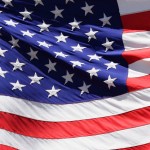Most of us learned growing up that during the Pledge of Allegiance we’re supposed to stand at attention facing the American flag with our right hands over our hearts. Persons in official uniform render military salutes. Hats should be removed unless part of a uniform or religious attire.
Less known is the fact that these practices are prescribed by federal law. The Flag Code in United States Code Title 4 Chapter 1 details proper behavior towards the American flag. While the Code was originally just a guide for flag etiquette created by the National Flag Conference in 1923, Congress made the Flag Code law in 1942.
Unlike other laws the Flag Code is not the type of federal rule under which people get arrested (though states can adopt their own laws). Instead, the U.S. Flag Code is advisory and provides proper procedures for using the flag during a parade, meeting or convention or when displaying the flag, such as at clubhouse. At more than 3,000 words, there’s a lot in the U.S. Flag Code. Here are some highlights from the Flag Code on when to display and how to show respect for the flag.
Time and Occasion
- The flag should only be displayed from sunrise to sunset on buildings and stationary flagstaffs. If properly illuminated, the flag can be displayed day and night.
- The flag should be “hoisted briskly” and “lowered ceremoniously.”
- The flag should not be flown in bad weather unless an all-weather flag.
- The flag should be displayed daily on or near the administration building of public institutions.
- The flag should be displayed in or near every polling place on election days.
- The flag should be displayed during school days in or near every school.
Manner of Display
- When carried with other flags, the U.S. flag should be on the “marching right” (that is, the flag’s own right). So if several flags are coming towards you, the U.S. flag should be to the far left. Another practice allows the U.S. flag to be placed in front of and at the center of a line of flags.
- When displayed with other flags with crossed staffs, the U.S. flag should be on the right (its own right) in front of the other flag.
- When a number of flags are grouped and displayed from staffs, the U.S. flag should be either at the highest point or in the center.
- When displayed over the middle of the street, the flag should be hung vertically with the stars (called the “union”) on top. The Flag Code even notes that the union should face north on an east-west street and east in a north-south street!
- In a meeting, convention or house of worship, the U.S. flag if on a staff should be placed to the speaker’s right (the audience will see the flag to the left of the lectern). Other flags are placed on the speaker’s left.
- The flag is sometimes flown at half-staff as a sign of mourning. In such instances, the flag is raised to the top for an instant, then lowered to half-staff. Before lowering the flag for the day, it is again briefly raised to the top. The President typically declares when and for how long the flag flies at half-staff.
- If displayed on an automobile, the flag’s staff should be firmly clamped to the right front fender of the automobile. The flag should never drape or cover any part of the car.
Again, these are just some of the rules regarding the manner of displaying the flag (for a complete list visit the U.S. Flag Code). While these guidelines may seem confusing, a simple rule taught to Boy Scouts applies in most situations: “Consider yourself the flag. Consider your right shoulder the blue field. Face people with yourself to the right.”
Respect for the Flag
While the Flag Code generally provides that “No disrespect should be shown to the flag of the United States of America,” there are a few specifics:
- The flag is never flown upside down except as a distress signal.
- The flag should never touch anything beneath it, such as the ground, floor, or water.
- The flag should never be carried flat or horizontally, but always aloft and free.
- The flag should never be used as wearing apparel or drapery.
- The flag should “never be used for advertising purposes in any manner whatsoever.”
- When the flag is raised or lowered, persons should salute the flag as with the Pledge of Allegiance (i.e., hand over the heart or a military salute if in uniform).
- During the National Anthem, persons should salute the flag as with the Pledge of Allegiance (though this situation is covered by a different law). If there is no flag, those present should face the music and act as if the flag were displayed.
- When the flag passes by you in a parade or entrance ceremony, the salute as described above should be given “the moment the flag passes.”
- When an American flag is in a condition that it must be destroyed, it should be disposed of in a dignified manner, preferably by burning. Many local fire departments and Boy Scout Troops will take U.S. flags for burning in a “flag retirement ceremony.”
As mentioned above, if you violate these rules from the U.S. Flag Code the flag police aren’t going to come and haul you away. So why follow them? As a lawyer, parliamentarian, and Eagle Scout, my answer will likely seem pretty old fashioned:
It’s the respect we show a flag that symbolizes our great country and represents far more than the material from which it’s made.
———————————————–
For specific issues related to the display of the flag in community associations, visit these posts: Regulation of Display of American and North Carolina Flags in HOA & Condominium Associations and Flag Displays in South Carolina Homeowners Associations and Condominiums.


